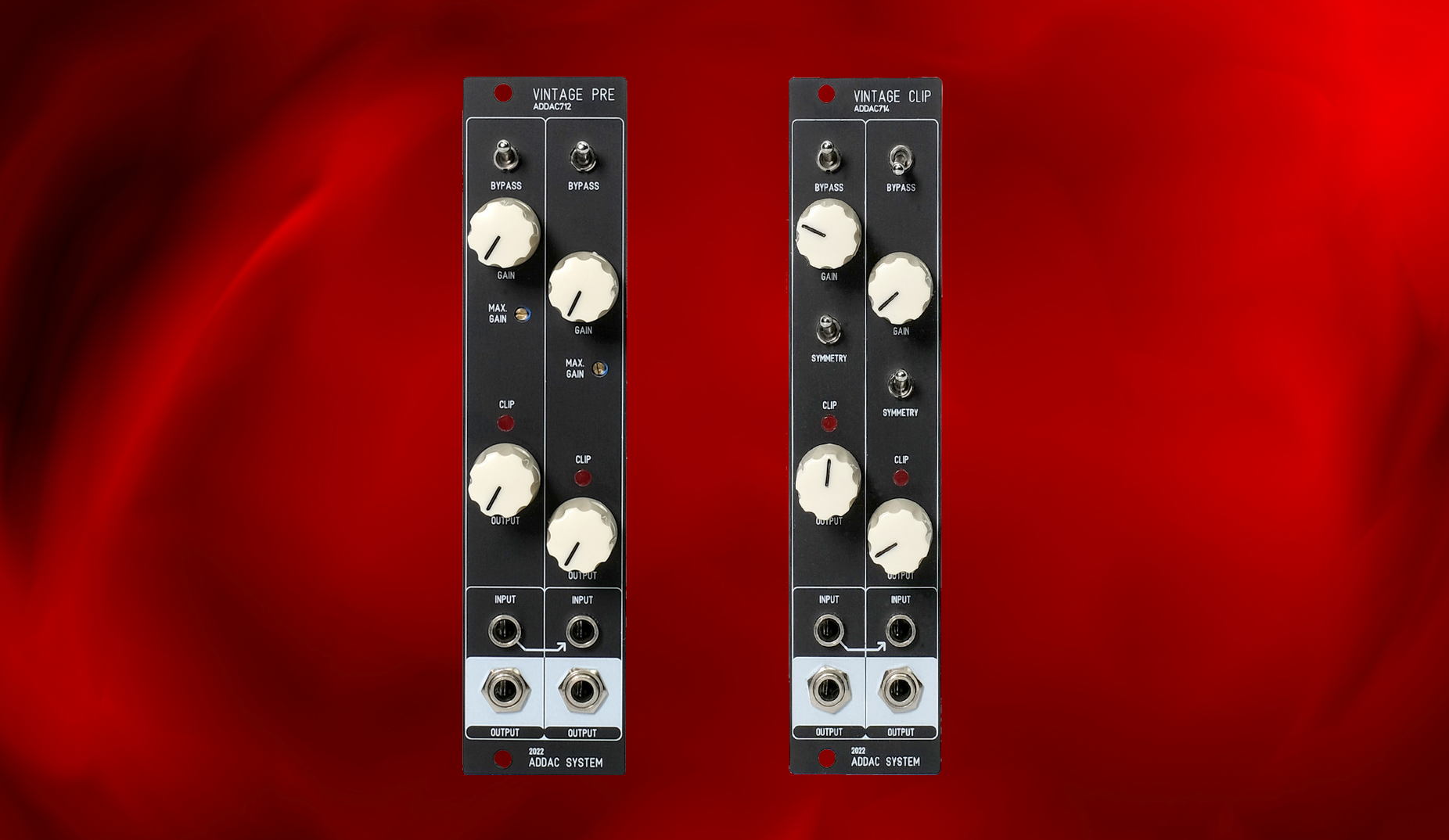ADDAC System Introduces Vintage Pre and Vintage Clipper
Based on classic analog circuitry from the '70s, new modules from ADDAC System impart a truly legendary sonic character
Lisbon, Portugal, December 15, 2022 — ADDAC System announces two new modules, both designed to impart a classic vintage character into your Eurorack signal chain. The ADDAC712 Vintage Pre and ADDAC714 Vintage Clipper are based on legendary analog equipment from '70s and are able to impart pleasing distortion, harmonics and saturation to the resulting signal while providing the user with plenty of sonic flexibility.

ADDAC712 Vintage Pre
ADDAC712 Vintage Pre is a dual channel discrete gain staging amplifier based on a famous discrete preamplifier from the 70’s. Its classic sonic character — including its pleasing clipping/saturation/distortion when it is pushed harder — can be used with modular signals as a preamp for an external source such as a line source, keyboard, guitar and other signals. It’s also a great side companion for the ADDAC711 Balanced Input module.
Its controls include an On/Off [BYPASS] switch at the top, which routes the signal into the Effect (Up: Active) or to the bottom output gain stage (Down: Bypassed). The amount of amplification is set by the [GAIN] control, and the maximum amount of amplification can be set by the user using the [MAX GAIN] trimmer.
Up to ±5.5v of the incoming signal will keep its integrity for a cleaner signal; beyond this point, saturation will begin to increase. At aprox. ±6v, a hard clipping will start to occur. This clipping also has a particular quality that at extreme levels it drifts the audio 0v bias reference, moving it upwards and resulting in something similar to a gate effect.
In the middle of the module, there is a x2 opamp based output gain stage with a clipping LED which monitors the clipping at the output, and finally an [OUTPUT] control to set the output volume. Having the top and middle gain stages provides flexibility, allowing the user to completely distort the signal on the top stage while taming its output level with the second stage. At the bottom, there is an Input and Output for both channels (The left input is normalled into the right input).

ADDAC 714 Vintage Clipper
Meantime, the new ADDAC714 Vintage Clipper is a dual channel soft clipping module. Diode-based passive clipping acts as a “brick wall” limiter with a fixed knee given by the inherent diode physics. A passive RC low pass circuit adds a 3.3KHz -3db low pass filter, which sculpts the overall tone while also adding further character to the audio signal.
At the top of the module, there is an On/Off [BYPASS] switch, which routes the signal into the Effect (Up: Active) or to the bottom output gain stage (Down: Bypassed). The amount of clipping is set by the [GAIN] control — it mostly works as a threshold control for how much clipping will be applied. As more clipping is applied, the signal’s amplitude will also decrease. To compensate for this, there is a gain compensation stage to keep the output amplitude balanced across the gain range.
Symmetry chooses between bipolar clipping or positive clipping. This relates to the harmonics generated: bipolar for odd and even harmonics (up position), and unipolar for odd harmonics only (down position).
At the second stage, an opamp based x2 output gain with a clipping LED, which monitors the clipping at the output, and an [Output] control to set the output volume. Having the top and middle gain stages provides more flexibility, allowing the user to completely distort the signal on the top stage while taming its output level at the second stage.
Both the ADDAC712 Vintage Pre and ADDAC714 Vintage Clipper are available now and priced at €140 and €130 respectively. Also, both modules are available as a DIY kit. For more information, please visit www.addacsystem.com.
ABOUT ADDAC SYSTEM
ADDAC develops advanced instruments for sonic expression. The company started back in 2009 with an ambition to explore the potential crossover between analog synthesizers and computers. Because its first creations sparked a lot of attention, ADDAC decided to work hard and put them in customers' hands. Today our product line is focused on a new breed of hybrid synths, that make use of the best of both the digital and analog worlds. We've grown to be able to reach thousands of enthusiastic clients, friends and collaborators. Always looking into conceptualizing and developing the most exquisite instruments, we hope you're able to join and share this passion with us.
Our solutions can be found in many personal studio throughout the world, owned by musicians in several planes of stardom. We especially appreciate seeing them being used in a very wide range of musical genres.
Jeff Touzeau





